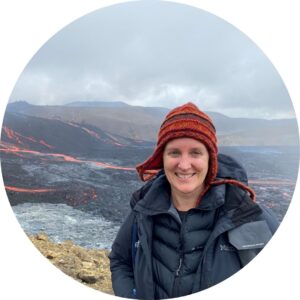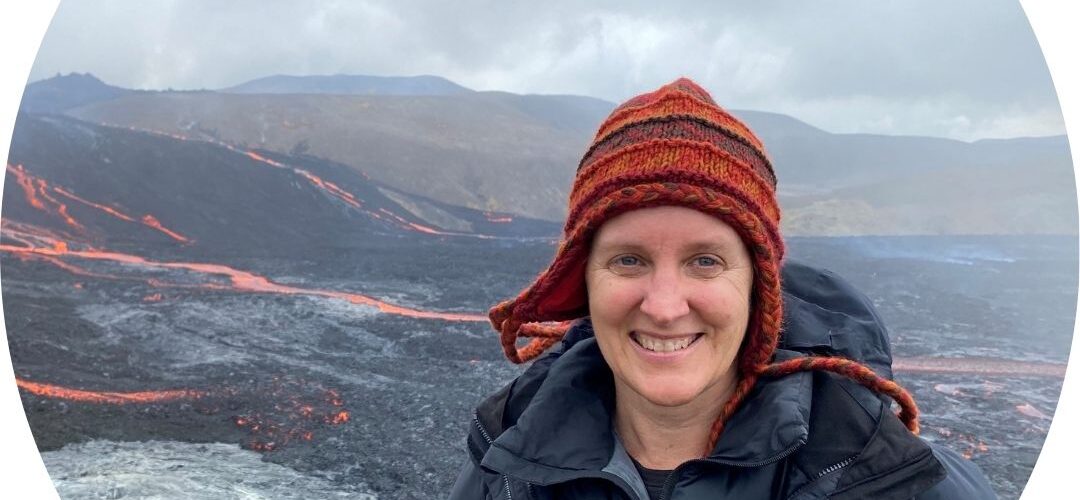Greetings Putney Travelers,
I hope you are getting excited and prepared for your upcoming excursion to Iceland. I am Katryn Wiese, your geology/volcanology/oceanography expert who will be joining you for a few days partway through your trip, and I very much look forward to meeting you and exploring this dynamic country with you.

I visit Iceland annually and was last there in July 2021, when I was lucky enough to visit and film, multiple times, the spectacular (and safe) eruption of the Fagradalsfall volcano in the Reykjanes region in the southwest of Iceland. This volcano is currently in a quiet phase, but it (or one of its neighbors) could restart at any time. You will be able to see this active volcanic zone as your plane arrives in Iceland (as it surrounds the airport). You may even see evidence of this region from Reykjavík, which is right nearby. Icelanders love their volcanoes as much as I do, and the country does an excellent job ensuring that volcano enthusiasts can access the eruptions safely. I look forward to sharing with you the video and photos and experiences I’ve had studying the volcanoes of Iceland over the years.
I first traveled to Iceland back in 1992, at the end of my first year as a graduate student, to study a very quiet, beautiful, and little-known volcano called Eyjafjallajökull. Learning how to pronounce the name of the volcano and the towns in Iceland was one of my first challenges, but one that when accomplished, made me feel more at home. The Icelandic language is an ancient and beautiful one. It was quite a surprise when, 18 years later, in 2010, Eyjafjallajökull erupted spectacularly, wreaking havoc with the airports in Europe and economies worldwide. Now it is quiet again, waiting.
Iceland’s landscape is continually changing, as volcanoes add new land, and the sea, glaciers, rivers, and waterfalls erode and sculpt that land into majestic structures. On this program, we will explore the places where waves and glaciers have carved canyons, cliffs, and fjords into ancient volcanoes, opening up their hidden history and stories. We will learn how the local communities live and adapt to changing climates: from energy use to food choices to economies. We’ll be exploring Icelandic history and culture, including the longstanding geologic, volcanic, and maritime influences on both.
During my professional career, my focus has been sharing Earth and Ocean Science with students of all ages, simplifying the complex, and drawing attention to processes and landforms in the natural world that are easily overlooked but that help us better understand our planet and how best to live on it. I look forward to getting to know each of you and helping you to explore this landscape and read the stories it has to tell. Whether during a talk, over a meal, or in the field, I will draw on my teaching and field experiences in Iceland and in other oceanic and volcanic landscapes to bring to life the dynamic geologic origins and history of Iceland. I encourage all of you to share your questions, experiences, and ideas.
In preparation for this trip, I have developed a web page with multiple online resources discussing the natural landscape and processes at work (photos, video tutorials, and articles). If you would like to get an overview of some basic geologic themes that we’ll be seeing and discussing during the trip, please explore these ahead of time:
https://fog.ccsf.edu/~kwiese/iceland.html.
Iceland is a land built by volcanoes, covered by bright green mosses and blueberries, and carved by glaciers and full and rushing rivers and waterfalls. I am looking forward to meeting you all this summer and sharing with you the beauty of Iceland and its surrounding ocean.
Sincerely,
Katryn Wiese
Professor of Geology and Oceanography, City College of San Francisco

